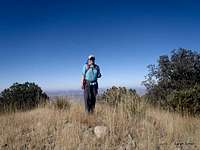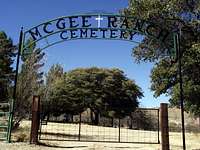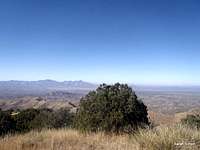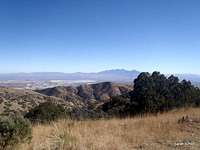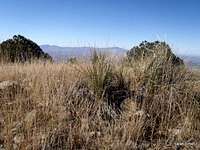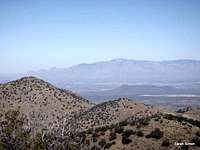-
 4765 Hits
4765 Hits
-
 83.1% Score
83.1% Score
-
 16 Votes
16 Votes
|
|
Mountain/Rock |
|---|---|
|
|
31.88650°N / 111.2145°W |
|
|
Pima |
|
|
Hiking |
|
|
Spring, Fall, Winter |
|
|
6180 ft / 1884 m |
|
|
Overview
Un-named and gentle, UN 6180 rises quietly in the Sierrita Mountains to the east of Arizona prominence peak Keystone Peak. From the summit of UN 6180, you are nearly surrounded by fellow Sierrita neighbors. Additionally, to the west rise the Baboquivari Mountains, anchored by the famous Baboquivari Peak. The Coyote Mountains peak out, like a spur, out just northeast of the Baboquivari Mountains. Mount Lemmon looms to the northeast above the Old Pueblo itself. Mount Wrightson and Mount Hopkins in the Santa Rita Mountains raise their sawtoothed selves on the eastern horizon.
The summit of UN 6180 is grassy with a few nice places to sit and watch the world go by on a nice day. The summit is readily accessible and a rough road/trail stretches from the primary dirt road toward the summit making navigation a snap. This is a good peak for the family or a relaxed Sunday stroll.
Rank: 1651st highest peak in Arizona
Prominence: 320 feet
USGS Quad: Samaniego Peak
Rank & Prominence: Lists of John
Getting There
Primary access from the east is via McGee Ranch Road.
From I-19, take exit #75 (Helmet Peak Road, Sahuarita Road). Take Helmet Peak Road west for approximately 5 miles. Turn left on Mission Road. You will reach a locked ranch gate at a water tower about 4.5 miles west of Mission Road. Parking is available around the water tower.
A route combining this peak with Placer Peak will be posted shortly.
Red Tape & Property Ownership
Property ownership of and public access to the Sierritas is, as they say, clear as mud. Property holdings are a checkerboard of confusion with private (including family ranch lands and corporate mining claims) and public holdings (Bureau of Land Management as well as State Trust Lands – which may be under lease) intermingled. Access, particularly from the east via McGee Ranch Road, has traditionally not been an issue. Please be friendly and respectful to all people you encounter and clean up after yourself, your party and others to ensure continued enjoyment of this area for the public.
Not the only privately-owned land in the area, but probably the best known is the area collectively knows as the McGee Ranch & Settlement.
The settlement on the eastern side of the Sierrarita Mountains dates to 1895 “when goldseekers James Riley McGee, David Lively, George Harris, and their families traveled west by wagon train toward California. When a wagon wheel broke, down at Chigger Hill, they stopped to repair the wheel and pan for gold. In 1898 they settled a permanent camp, predating Arizona statehood. Three years later a prospector guided them to an abandoned ranch where an English homesteader left a fireplace, a rock sheep and goat corral, fig and apricot trees, grape, bean, “squaw corn” fields. The settlement continues there today.*
*Green Valley, Arizona
- By Philip Goorian
Camping & Lodging
There is no camping via the McGee Ranch and Settlement access from the east. Most visitors to Placer Peak will be residents of or visitors to the general Tucson metropolitan area and will not need overnight camping or lodging.
There are a handful of hotels in nearby Green Valley, Arizona. Visit the Green Valley area TripAdvisor page for more information.
Weather & Seasons
| Month | Avg High | Avg Low | Mean | Precip | Rec High | Rec Low |
|---|---|---|---|---|---|---|
| Jan | 66°F | 40°F | 53°F | 0.94 in | 88°F (1927) | 6°F (1913) |
| Feb | 69°F | 42°F | 56°F | 0.89 in. | 92°F (1957) | 17°F (1899) |
| Mar | 74°F | 46°F | 60°F | 0.73 in. | 99°F (1988) | 20°F (1965) |
| Apr | 82°F | 52°F | 67°F | 0.31 in. | 104°F (1989) | 27°F (1945) |
| May | 92°F | 61°F | 77°F | 0.23 in. | 111°F (1910) | 32°F (1899) |
| Jun | 100°F | 69°F | 85°F | 0.20 in. | 117°F (1990) | 43°F (1908) |
| Jul | 100°F | 75°F | 88°F | 2.25 in. | 114°F (1995) | 49°F (1911) |
| Aug | 97°F | 73°F | 85°F | 2.39 in. | 112°F (1993) | 55°F (1917) |
| Sep | 95°F | 69°F | 82°F | 1.29 in. | 107°F (2000) | 43°F (1913) |
| Oct | 85°F | 57°F | 71°F | 0.89 in. | 102°F (1993) | 26°F (1971) |
| Nov | 74°F | 46°F | 60°F | 0.57 in. | 94°F (1924) | 19°F (1921) |
| Dec | 65°F | 39°F | 52°F | 0.93 in. | 85°F (1939) | 10°F (1901) |
 Click for weather forecast | In general, expect mild temperatures in winter, often sunny and dry by day and cold and clear at night. The heat in the summer can be extreme and even dangerous. Use caution during the summer monsoon season as washes can flood during heavy rains. |  Click for weather forecast |





